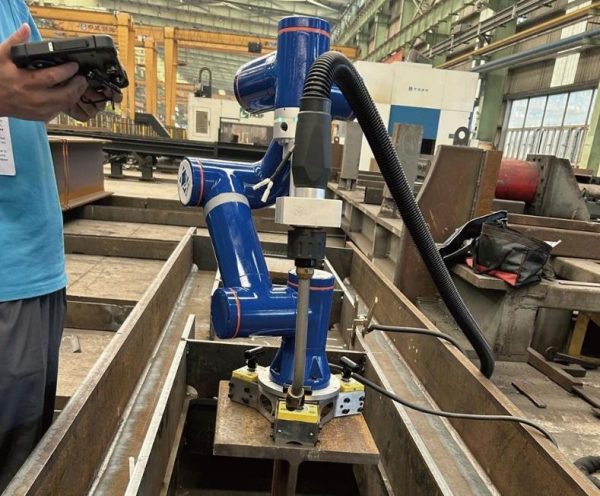
Steel plate is one of the most common materials used everywhere from construction to automotive and aerospace. It has incredible versatility, is strong, and is durable. It’s what you need all of the time in manufacturing applications. Suppose you are building a heavy structure, creating complex machines, or even using a robotic welder for precision welding. In that case, a metal plate is an integral part of making the job a reality. What exactly makes steel plate so valuable? How about in manufacturing, where companies depend on steel plates? There are industrial uses in what?
The purpose of this article is to inform others about steel plate’s industrial applications, benefits, and support for modern manufacturing processes like robotic welding and fabrication. In addition, we will explore how steel plate can be formed to meet the needs of particular industries.
Why Steel Plate Is Essential in Manufacturing?
The strength-to-weight ratio, resistance to wear, and adaptability of steel plate to a variety of environments make it an excellent choice for applications such as machine guarding, repair, reconstruction, prototyping, tooling, acoustic control, aerospace components, naval construction, slingsheets, tanks, dished ends and as construction material. Unlike other materials, it is customizable by changing its thickness, grade, and finish to meet a particular requirement. Steel plate offers this flexibility, making it perfect for industries with strict requirements for a material that can still work under extreme conditions, whether that be in high-stress areas or severe weather.
Almost everything we build in the world is made from steel plates, from bridges and railways to ship hulls and large machinery. The material’s applications are far greater than its engineering uses, which is the largest reason why it is still a key material in the manufacturing world.
Common Types of Steel Plate
Not all steel plates are the same and not all have the same properties and uses. Let’s take a quick look at the most common ones:
- Carbon Steel Plate: Carbon steel is the most widely used type of steel plate. It has excellent strength and machinability. This material is used in tanks, pipelines, and heavy equipment.
- Stainless Steel Plate: A known corrosion-resistant material, stainless steel is suited for use in applications that demand a constant, rust-resistant material. It is commonly used in the food processing industry, medical equipment, and chemical processing.
- Alloy Steel Plate: This plate has elements such as chromium, molybdenum, or nickel added to improve performance under high-stress, high-temperature environments. It’s often used in industries like oil and gas, aerospace, and automotive manufacturing.
- Wear-Resistant Steel Plate: Wear-resistant plates are named because they are meant to withstand heavy abrasion. They are often found in mining, construction, and material-handling equipment.’
Industrial Uses of Steel Plate in Manufacturing
Maintainable and durable, steel plate is sought after around the world in such a wide variety of applications that it finds a home in every industry. Below are just a few of the many industrial uses of steel plate in manufacturing.
- Construction and Infrastructure.
Steel plate is used to construct beams, columns, and frameworks for bridges, skyscrapers, and warehouses. It is also very important to build roads, tunnels, and pipelines. For large-scale infrastructure projects, the material can handle heavy loads and resist environmental wear, and it is, therefore, a favored choice.
For example, steel plate is usually used to build bridge decks, support beams, and even the foundation. The strength of the material makes it possible to use bridges without fear that traffic and aging elements will pile on and knock them down.
- Shipbuilding
Steel plate is an integral part of the shipbuilding industry, used for the construction of hulls, decks, and other structural items. Corrosion resistance is critical because ships are exposed to water, salt, and a variety of weather conditions and in buildingships that will be used in harsh marine environments. Durability and ability to resist rust or corrosion make stainless steel plates a hit amongst buyers.
- Heavy Machinery and Equipment
In manufacturing industries, steel components are needed in heavy machinery and heavy equipment that are subject to enormous stress and mechanical wear. The steel plate has everything from robotic welders for precision fabrication to large-scale construction equipment like bulldozers and excavators. Its versatility permits manufacturers to use it in machinery frames, gearboxes, and engine blocks, as well as in parts subjected to high temperatures and abrasive environments.
- Automotive Manufacturing
In addition to producing both interior and exterior components, steel plates are also used in the automotive industry. For example, steel plates are commonly used in the formability and strength of body panels, chassis, and engine components. In addition to drastically speeding up the welding process while maintaining high quality joints and finishes, the robotic welder has also revolutionized how these steel plates are welded.
- Oil and Gas
In the oil and gas industry, steel plates are indispensable to the construction of pipelines, pressure vessels, and storage tanks. A critical attribute of the material used in these high risk environments is its ability to resist extreme temperatures and pressures. Whether it’s building rigs or making sure an oil platform is structurally sound, steel plate is a trusted material capable of standing up to the rough and harsh conditions in the industry.
The Role of Robotic Welders in Steel Plate Fabrication
The integration of robotic welders is one of the major steps in steel plate fabrication. When you’re welding large sheets or plates of steel, you need these automated systems to make precise, repeatable welds. A very important industry where robotic welders have revolutionized to this day is automotive manufacturing.
Welding large steel plates was a long, difficult process in the past. Yet, with robotic welding systems on the rise, manufacturers can now automate the process, reducing the prospect of human error or at least reducing it to a minimum. As with robotic welders, advanced sensors and AI are integrated into robotic welders to the point of enabling them to detect and make adjustments for variations in material for high-quality welds regardless of the configuration of the part that must be welded.
Conclusion
Steel plate is one of the most important materials today because it is used industrially in so many ways and for such diverse applications. It is used in everything from aerospace and energy to construction and automotive, helping make the equipment behind our world economy. The steel plate situation will be central to industrial innovation as industries grow and automation in the form of a robotic welder becomes more advanced.
With durability, precision, and customization as the keys to survival in a world today that is driven and characterized by such, steel plate becomes an enduring answer, one that is prepared at every turn to adapt to the rigors of even the most demanding industrial demands.




